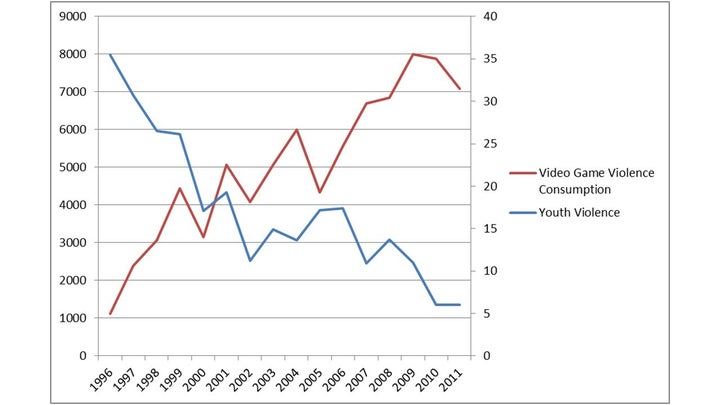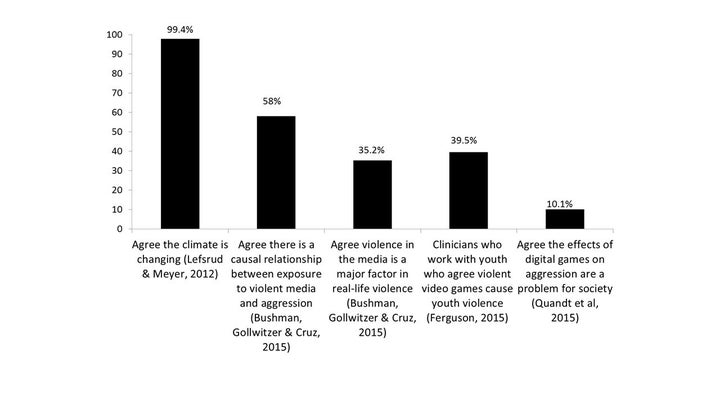The American Academy of Pediatrics (AAP) has a long history of releasing policy statements on media which are both wildly alarmist and grossly inaccurate. These include their controversial claims about “Facebook Depression” in 2011, their problematic and unrealistic recommendations on screen time, and past biased statements regarding media violence, which once infamously inflated the number of studies by a factor of about ten (mistakenly claiming 3500 studies existed when, in fact, there were a couple hundred). In July, 2016, the AAP have added to their unscientific litany a new policy statement that reads as strangely defensive and frustrated (indeed, ironically enough, even “aggressive”) but distorts the research evidence as more consistent and worrisome than it currently is.
Consistent or Inconsistent Results?
First, the AAP presents the results on media violence as if they were consistent. They argue that “hundreds” of studies show that “…the linkage between virtual violence and aggression has been well supported and is robust.” But this claim is easily contradicted by a whole host of studies that find no effect for media violence on aggression. Other studies have examined links between media violence consumption and societal violence and found that media violence is, if anything, associated with reduced societal violence. This is not to say evidence is consistent against effects either. Some studies do find some evidence for media effects (although typically small and usually for minor behaviors) yet others do not. Claiming consistency in either directly merely discredits the claimant as a credible source of information.
This claim also ignores increasing controversies about media effects’ role in psychology’s replication crisis. Scholars have identified “questionable researcher practices” in this realm, and have had difficulty replicating old studies, and studies using preregistered designs (where scholars publish their methodology in advance of collecting data, making it harder for them to monkey with analyses to get the results they want), generally found little evidence for effects.
The AAP, in effect, employs “citation bias”, ignoring studies that don’t fit their policy. Indeed, the AAP cited very few studies at all, the majority of which come from only two controversial psychologists. As scholars have noted, this is an inappropriate scholarly behavior, and arguably may be of questionable ethics.

A Scientific Consensus?
The AAP claims the presence of a consensus of scholars and practitioners regarding media effects. However, most surveys of scholars and clinicians reveals this to be false. Depending on how questions are asked, surveys indicate that only 10% to 58% of scholars agree some kind of links may exist. Higher numbers are found when undefined “aggression” is used in queries (which could involve fairly minor laboratory tasks like filling in the missing letters of words...”kill” being more aggressive than “kiss” for instance in response to ki__), and drop significantly once questions ask about youth assaults or other significant behaviors. All surveys indicate significant disagreements among experts, with only a minority worried about media effects on violent behavior. Indeed, past claims of consensus have been thoroughly discredited.
Further, a group of 230 scholars, back in 2013, wrote an open letter advising against policy statements on media effects just like this one. That letter was written to the American Psychological Association (APA), but the same principle holds here. How does the AAP pretend this large group of 230 scholars don’t exist?
The AAP also appears unusually aggressive toward skeptical scholars, referring to them as “contrarian.” The AAP appears to have forgotten that being skeptical (indeed contrarian) is arguably a big part of being a scientist.

Meta-Analysis to the Rescue?
The AAP claims that meta-analyses of studies (a statistical approach to combining individual studies to look for overall effects) support the presence of effects. Once again, they rely entirely on meta-analyses conducted by the same two controversial scholars. Other meta-analyses that concluded the evidence for media violence effects is shaky were simply ignored by the AAP. One 2010 meta-analysis the AAP did cite has come under recent scrutiny for the potential that its results may be due to publication bias (the tendency for journals to publish significant findings and reject non-significant findings, thus distorting the scientific literature) and other problems rather than “real” effects.
Misreading the US Supreme Court.
Back in 2011, the US Supreme Court (SCOTUS) evaluated the scientific evidence for violent video game effects. The majority decision, striking down regulation restricting the sale of violent games to minors, declared of the research ““These studies have been rejected by every court to consider them, and with good reason” and went on with specific criticisms.
Yet, in their policy statement, the AAP claim “Rather than rule on scientific merit, the Court invoked first-amendment protection for the games insofar as the Court construed their primary purpose to be to confer ideas and social messages.” The AAP doesn’t seem to have read the SCOTUS decision carefully, if at all. Although certainly First-Amendment protections were a primary issue of concern to SCOTUS, they did specifically comment on scientific merit, and the scientific merit (an element of what’s called “strict scrutiny”) was a major part of the case. SCOTUS specifically decided that the evidence was insufficient to support the claim that violent games “harmed” children.
Comparisons with Medical Effects.
The AAP, at one point, compares media violence effects to those of passive smoking on lung cancer, saying that the effects for media violence are, if anything, larger. This is basically the repetition of a scientific urban legend. Such claims have long since been statistically debunked, and other scholars have specifically referred to such medical comparisons as sensationalist rather than scientific.
Is the AAP in Support of Censorship?
What seems to come out in the AAP’s policy statement is a sense the organization is frustrated and trying to dominate the debate. It’s almost as if the AAP have a product they are trying to sell, and are aggressively shouting down warnings their product might be flawed. At times, this arguably puts the AAP in the position of appearing to support censorship.
First, several of the AAP’s policy recommendations appear to be blatantly unconstitutional. These include the call for lawmakers to “enact laws that prohibit easy access to violent media for minors” and to develop a government run ratings system for media. Neither of these government intrusions into the regulation of media are allowed (at least as I understand constitutional law.) The Supreme Court decision described earlier specifically prohibits laws regulating the availability of violent media to minors. I understand that some folks (particularly older adults) may like the sound of regulating media sales to minors, but it’s illegal under the First Amendment, so recommending it as policy is a moot issue.
But more worrisome, the AAP appear to pressure journalists not to speak to anyone, including “contrarian scholars” who disagrees with their position. This arguably puts the AAP in the bizarre and aggressive position of, in effect, arguing for scientific censorship (whether or not this was their intent). They chide news media for presenting “both sides” of the debate (despite the presence of scientific evidence for both sides and the fact that most researchers do not agree violent media poses a serious risk to society) and offer as a recommendation “The news and information media should acknowledge the proven scientific connection between virtual violence and real-world aggression…”
Why Parents and Policy Makers Can Ignore This.
In a way, the AAP policy statement actually is an amusing read, in the sense that it can often be entertaining to read the extreme views of folks who appear to have dug themselves into a deep trench. Of course there’s always the risk some people might take this seriously. Here’s why you shouldn’t.
First, almost nothing in the AAP policy statement is actually true. Most of their claims can be discredited even with a relatively simple Google search. They are not representing a scientific field that actually exists in the form they describe.
Second, there are conflicts of interest at play. The lead author of the policy statement is, himself, a scholar involved in promoting the “harm” view of media, effectively considering his own research and that of close colleagues and declaring it beyond debate. I’d love to be able to do this with my research one day. This has actually been a consistent problem with policy statements by both the AAP and APA (full disclosure, I am a fellow of the APA), which have allowed scholars with vested interests in one side of the debate to write policy statements rather than soliciting neutral views. This is terrible scientific practice.
Third, ultimately it’s important to remember that groups like the AAP and APA are not objective arbiters of truth, but rather professional guilds. Scholars and clinicians like myself pay these organizations to represent our professional interests…in effect, help us get scientific grants, professional prestige, even newspaper headlines. That’s why it’s such a blatant problem for these organizations to use scholars with clear conflicts of interest to write their policy statements. But these organizations are arguably motivated to find problems for their members to “fix” whether those problems are real or not. Saying “the evidence is mixed” or “we don’t know” is not in these organization’s interests, even if that’s the truth.
Ultimately, this policy statement misinforms rather than informs. It further cements the AAP’s reputation as society’s neurotic nanny on the topic of media (a role with which it often competes with the APA.) It is a statement of rigid ideology, not science and, as such, should be regarded as an amusing curiosity, not a platform for good policy or parenting practices.
